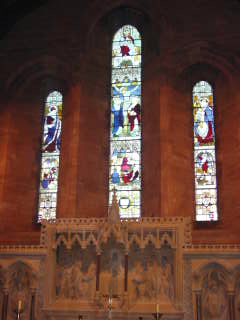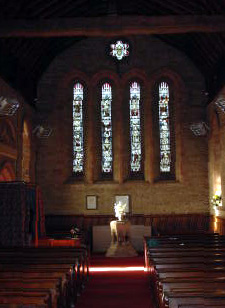The windows in the church are mainly of stained glass, an old craft which had become unfashionable in the seventeenth and eighteenth centuries, but which was revived along with Gothic architecture in the nineteenth century. The single lancet windows along the north and south walls were intended to depict the twelve apostles as listed by Luke (Luke 6: 12-16), but three windows are blank (Matthew, Thomas and Matthias (who replaced Judas.) One of these blank windows has now been replaced by Graham Chaplainís and Pat Followsí "Millennium Window", donated to the Church by Villagers and Friends of Hints in the year 2000. This depicts Christ as evinced in various passages in the Book of Revelations triumphing over Satan, represented as a serpent crushed at his feet. The references to the nativity and the crucifixion and the Alpha Omega monogram signify the beginning and the end.The windows are arranged in a significant sequence around the walls. On the south side immediately to the right as one turns through the door is St Bartholomew, to whom the church is dedicated. He is named but is also identifiable by his attribute, the knife with which he was martyred.
The next pair of windows depicts St Jude and St Simon, shown together because they share 28 October as their saintís day. The window after the steps is that of St John the Evangelist, distinguished as such by the fact that in the lower level he is depicted (in the manner of mediaeval illuminated manuscripts) in the act of writing his gospel. Then comes St James with the staff of the pilgrim, his attribute.
The east windows (over the altar) 
On either side of the altar are the two leading apostles, St Peter with his key and St Andrew with his X shaped cross of martyrdom. The three windows above the altar depict scenes connected with Christ. The number three signifies the Holy Trinity. The left window, upper level, shows the prophet Isaiah, identifiable by the words in the scroll "Behold, a virgin shall conceive and bear a son" (Isaiah 7: 14.) This prophecy is shown in fulfilment on the lower level, where the Nativity is depicted.
The right-hand window at the upper level shows David, identifiable both by the harp which is his attribute and by the words in the scroll "For Thou wilt not leave my soul (in hell)" (Psalm 16: 10), which forms a link with the theme of everlasting life and salvation symbolised in the lower level, where Christís emergence from the tomb at the Resurrection is shown. These two windows show how the Old and New Testaments relate to each other.
The centre window depicts, at the apex, Christ in Majesty after the Ascension, underneath which is the Crucifixion, and below that, the Agony in the Garden.
The north windows The remaining pair of stained windows, to the left of the organ, are of St James the Less and St Philip (whose cross was T shaped, like Christís) shown together because they share a common saintís day, 1 May.
The west windows 
The west windows are later than the rest, being given by Mrs Chadwick in memory of her husband who died in 1892. They were designed by Charles Eamer Kemp, whose windows are also to be found in Gloucester and Bury St Edmunds cathedrals and in Southwell Minster. The windows depict the four archangels, and below them the heavenly host. Nearest the door is Gabriel, identified by his attribute the lily (referring to the purity of the Virgin Mary) and by the words in the scroll "Ave Maria Gratia Plena", "Hail Mary, thou that are highly favoured" (Luke 1: 28.) Next is Raphael, who holds in his left hand a staff and two fish, which recall the story of Tobias and the Angel Raphael in the Apocrypha (Tobit, 6: 3-5.) The third window shows St Michael with his sword and the dragon of evil.
The last window shows Uriel, whose name means Light of God, the clue to his identity being the words in the scroll "Fiat Lux", "Let there be light". The small circular window at the apex is a modest version of the rose windows to be found in mediaeval gothic cathedrals. Its shape is symbolic, the outer circles representing time on earth - past, present and future- and the centre, with Christís monogram IHS, time eternal.